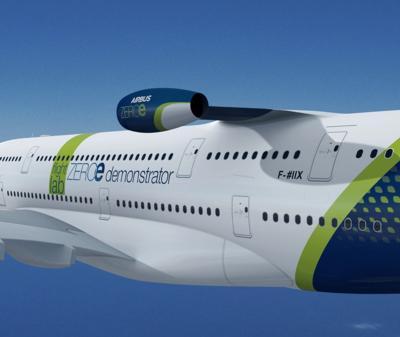Thu, Feb 24, 2022
A380 Testbed Will Analyze Efficiency, Engine Emissions in Flight
CFM and Airbus have announced a joint demonstration aircraft aimed at testing next-generation hydrogen tech.

Using the element as the basis for a sustainable fuel system has long been a goal in the industry, but until recent breakthroughs in storage and processing were made, it remained little more than a futuristic curiosity. Now, with investor interest higher than ever in sustainable, green fuels and the industrial backbone to create necessary liquid hydrogen in the works, the time is right for CFM to work with Airbus and complete a direct combustion engine. Should development proceed smoothly, the firms expect an entry into commercial service by 2035.
In order to run on the unorthodox fuel, the GE PassportTM turbofan will require modification to the combustor, fuel system, and control system. The engine was selected for its physical size, advanced turbo layout, and impressive fuel flow capability, being small enough to be mounted along the rear fuselage of the flying testbed to allow engine emissions to be monitored separately from those powering the aircraft up front. Of course, CFM affirms that it will complete ground testing long before ever placing an active engine into the air.

In partnering with Airbus, their program will use an A380 flight testbed equipped with specially designed and installed liquid hydrogen tanks built at the France and Germany factories. Airbus will define the hydrogen propulsion system requirements, oversee flight testing, and provide the A380 platform required in order to test the hydrogen combustion engine in cruise phase, with CFM handling the technical, design, and developmental side of the project.
“This is the most significant step undertaken at Airbus to usher in a new era of hydrogen-powered flight since the unveiling of our ZEROe concepts back in September 2020,” said Sabine Klauke, Airbus chief technical officer. “By leveraging the expertise of American and European engine manufacturers to make progress on hydrogen combustion technology, this international partnership sends a clear message that our industry is committed to making zero-emission flight.”
More News
He Attempted To Restart The Engine Three Times. On The Third Restart Attempt, He Noticed That Flames Were Coming Out From The Right Wing Near The Fuel Cap Analysis: The pilot repor>[...]
Make Sure You NEVER Miss A New Story From Aero-News Network Do you ever feel like you never see posts from a certain person or page on Facebook or Instagram? Here’s how you c>[...]
From 2009 (YouTube Edition): Leading Air Show Performers Give Their Best Advice for Newcomers On December 6th through December 9th, the Paris Las Vegas Hotel hosted over 1,500 air >[...]
Aero Linx: NASA ASRS ASRS captures confidential reports, analyzes the resulting aviation safety data, and disseminates vital information to the aviation community. The ASRS is an i>[...]
“For our inaugural Pylon Racing Seminar in Roswell, we were thrilled to certify 60 pilots across our six closed-course pylon race classes. Not only did this year’s PRS >[...]
 NTSB Final Report: Rutan Long-EZ
NTSB Final Report: Rutan Long-EZ ANN FAQ: Turn On Post Notifications
ANN FAQ: Turn On Post Notifications Classic Aero-TV: ICAS Perspectives - Advice for New Air Show Performers
Classic Aero-TV: ICAS Perspectives - Advice for New Air Show Performers ANN's Daily Aero-Linx (06.28.25)
ANN's Daily Aero-Linx (06.28.25) Aero-News: Quote of the Day (06.28.25)
Aero-News: Quote of the Day (06.28.25)




